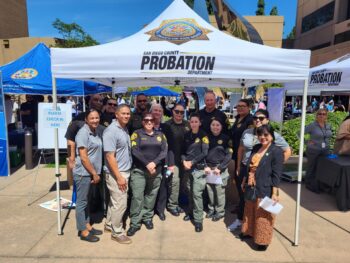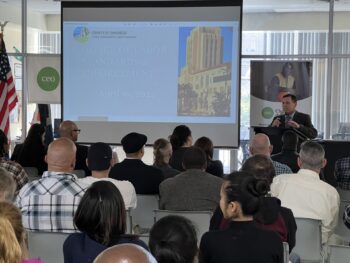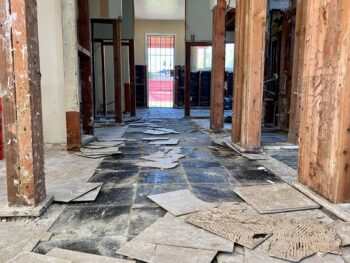Thousands of the region’s backcountry residents count on their rural fire departments for protection.
Even small fire stations with volunteer staffs are expected to halt a burgeoning wildfire and help sick and injured patients.
But buying reliable fire equipment is a challenge for small agencies. A single fire engine can cost half a million dollars; even basic medical equipment to assist breathing or immobilize patients with spinal injuries can quickly run into the tens of thousands of dollars.
But two seemingly disparate County departments are working together to make sure rural communities are protected: The San Diego County Fire Authority, which supports 15 rural fire agencies, including nine volunteer fire departments, and the County’s Housing and Community Development Department, which administers federal funds for improving low- and moderate-income communities.
In the past few years, the County has purchased 21 new fire engines and rescue vehicles and 17 new water tenders to cover the backcountry fire stations. So far, federal Community Development Block Grants—or CDBG funds— administered by Housing and Community Development have paid for 40 percent of the new equipment.
A combination of funding sources, including other grants, has paid for the other 60 percent.
“The (CDGB) funds have had a significant impact on the improvements we’ve been able to offer,” said Ken Miller, Fire Services Coordinator for the Fire Authority.
The fleet grows
Descanso is the latest community to benefit. In March, the Descanso Rural Fire Station will get a new engine for fighting structure fires—and in a lightly-developed community like Descanso, a structure fire poses a regional threat, because it can spark a wildfire.
The engine cost $490,000. CDBG funded $250,000; the County Fire Authority paid for the balance.
Over the last 18 months, CDBG funds have sent equipment including water tenders, fire engines, and emergency medical gear to Warner Springs, Sunshine Summit, Ranchita, Ocotillo Wells, Campo, Boulevard, Shelter Valley, Potrero, Lake Morena, and Dulzura.
Miller said the Fire Authority, which formed in 2008 and has a $15 million annual budget, has been able to use federal funds and other funding sources to equip backcountry fire stations in a relatively short period.
“This is really unique in the fire service to get this many pieces of apparatus in such a short time,” Miller said. “In many agencies, you’re lucky to get one a year. We’re comparable to large departments such as LA County, as far as the timelines go.”
Miller credits a good part of the Authority’s success in equipping the backcountry to the Housing and Community Development department’s commitment of CDBG funds.
How Housing and Community Development aids fire protection
The County’s Housing and Community Development department administers CDBG funds from the U.S. Department of Housing and Urban Development, or HUD, for the region. The amount the federal government allocates to the region each year varies, and the funds must be used for community improvements or affordable housing in low- to moderate-income areas.
This year, HCD is allocating just over $2 million in funding for the County’s unincorporated areas.
County departments, such as Public Works and Parks and Recreation, outside nonprofits and even individuals apply to HCD for CDBG funds for a wide variety of qualifying projects such as improvements to neighborhood parks, sidewalks to make pedestrians safer and new air-conditioning for a senior center.
CDBG funds can also be used for purchasing fire equipment for low and moderate-income communities.
“We’re responsible for 1.5 million acres, and many of the areas we cover are lower-income areas, so this is a great opportunity,” Miller said.
Each year, HCD submits its recommendations for CDBG-funded projects to the Board of Supervisors, which then approves an annual plan.
Since 2000, HCD has committed to recommending at least $200,000 a year for rural fire protection.
When a project slated for funding in the annual plan falls through—for example, a completed project comes in under budget and has funds remaining, or a low-income housing project’s construction schedule falls behind—HCD must direct those funds to another qualifying project.
Over the past few years, backcountry fire protection has frequently benefitted from these “leftover” or “mid-year” CDBG funds. The $250,000 for the Descanso Volunteer Fire Department’s new engine was funded that way, after the Board approved the re-direction of the CDBG funds in January.
“During the middle of the year we go to the Board with special recommendations,” said April Torbett, an HCD analyst who works on the CDBG program. “…frequently, that’s been for fire equipment; we know it’s a top priority for the Board and the community.”
Torbett said the Fire Authority’s formation in 2008 has made steering CDBG funds towards rural fire protection easier, and the Fire Authority helps ensure that the purchases fit regional priorities. Before the Authority’s formation, disconnected volunteer stations might apply for funds for new engines, and it was hard for HCD to know which was the greater priority.
These days, the Fire Authority does a “needs assessment” of all the stations and agencies it supports, and HCD relies on that information.
“When you deal with a Fire Authority, they know the needs of all the stations under their umbrella,” Torbett said.





